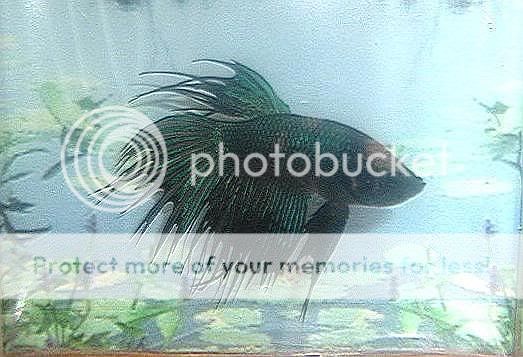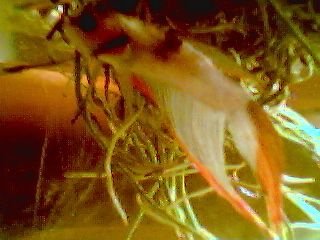SRC
Some days even my lucky rocketship underpants won'
The black and green crowntail I bought a month ago has started turning colors for some reason.
I thought he was turning into a marble (still not sure he isn't) but everyday he loses more black and green and turns clear/white in sections.
It started off on one side of his head, then he got a spot on his side, then the spot on his head got larger, and then another spot on his other side showed up. Now a large section on his back and across both sides, including a small portion of his anal fin have turned this color as well.
There is no *hairy* or slimy texture to the sections...just a loss of color. To be honest...if you could "rub" the color off a betta..that's what these sections look like. Kinda like a painted flower pot that has been painted a long time and some of the paint has worn off.
He eats fine, blows bubble nests, has no clamped fins, has no missing scales, has no fin rot, no clouded eyes, still flares actively..does nothing out of the ordinary that I can tell (not saying he doesn't...just saying I haven't noticed anything odd lately).
Wierdest thing I've ever seen.
Here is his AB picture

Here you can see no white patches
Here is a picture 2 weeks later

Here you can see his head has turned white
Here is a picture from last week

Here you can see his head is even whiter, and there are white patches on his back and one on his side
Any idea's?
I thought he was turning into a marble (still not sure he isn't) but everyday he loses more black and green and turns clear/white in sections.
It started off on one side of his head, then he got a spot on his side, then the spot on his head got larger, and then another spot on his other side showed up. Now a large section on his back and across both sides, including a small portion of his anal fin have turned this color as well.
There is no *hairy* or slimy texture to the sections...just a loss of color. To be honest...if you could "rub" the color off a betta..that's what these sections look like. Kinda like a painted flower pot that has been painted a long time and some of the paint has worn off.
He eats fine, blows bubble nests, has no clamped fins, has no missing scales, has no fin rot, no clouded eyes, still flares actively..does nothing out of the ordinary that I can tell (not saying he doesn't...just saying I haven't noticed anything odd lately).
Wierdest thing I've ever seen.
Here is his AB picture

Here you can see no white patches
Here is a picture 2 weeks later

Here you can see his head has turned white
Here is a picture from last week

Here you can see his head is even whiter, and there are white patches on his back and one on his side
Any idea's?







 He almost for sure has "NTD" - Neon Tetra Disease. It can affect any kind of fish, and I've seen the exact same thing happen to a betta. He got the pale spots on his head first, then it spreads along the dorsal area to the entire body/fins and soon, he'll probably have receding fins and muscle loss. He's sort of "waste" away. Actually, looks like the white areas are beginning to atrophy already.
He almost for sure has "NTD" - Neon Tetra Disease. It can affect any kind of fish, and I've seen the exact same thing happen to a betta. He got the pale spots on his head first, then it spreads along the dorsal area to the entire body/fins and soon, he'll probably have receding fins and muscle loss. He's sort of "waste" away. Actually, looks like the white areas are beginning to atrophy already.  Argh, I feel awful to tell you all this, because NTD is incurable. My mom's betta died from it, and I wish I been able to euthanize, because he really suffered in the end.
Argh, I feel awful to tell you all this, because NTD is incurable. My mom's betta died from it, and I wish I been able to euthanize, because he really suffered in the end. 


 So I'm having a hard time understanding where this woudl have come from...seeing how his water is changed daily...and no one else is giving off symptoms like this.
So I'm having a hard time understanding where this woudl have come from...seeing how his water is changed daily...and no one else is giving off symptoms like this. GAH!
GAH!